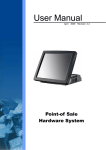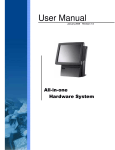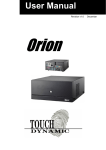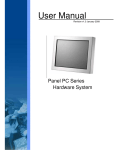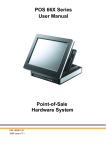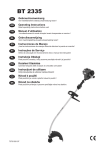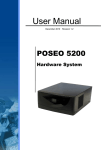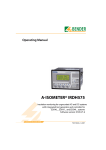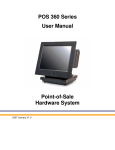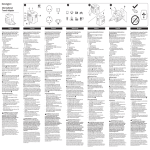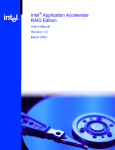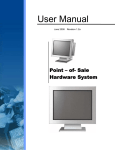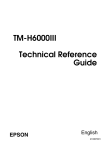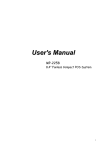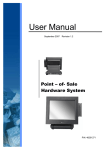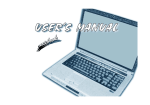Download Flytech POS 460 User`s manual
Transcript
User Manual ʳ ʳ February 2009 Revision 2.3 3RLQWRI6DOH +DUGZDUH6\VWHP Copyright 2009 February All Rights Reserved Manual Version 2.3 The information contained in this document is subject to change without notice. We make no warranty of any kind with regard to this material, including, but not limited to, the implied warranties of merchantability and fitness for a particular purpose. We shall not be liable for errors contained herein or for incidental or consequential damages in connection with the furnishing, performance, or use of this material. This document contains proprietary information that is protected by copyright. All rights are reserved. No part of this document may be photocopied, reproduced or translated to another language without the prior written consent of the manufacturer. TRADEMARK Intel®, Pentium® and MMX are registered trademarks of Intel® Corporation. Microsoft® and Windows® are registered trademarks of Microsoft Corporation. Other trademarks mentioned herein are the property of their respective owners. -1- Safety IMPORTANT SAFETY INSTRUCTIONS 1. 2. 3. 4. 5. 6. 7. 8. 9. To disconnect the machine from the electrical Power Supply, turn off the power switch and remove the power cord plug from the wall socket. The wall socket must be easily accessible and in close proximity to the machine. Read these instructions carefully. Save these instructions for future reference. Follow all warnings and instructions marked on the product. Do not use this product near water. Do not place this product on an unstable cart, stand, or table. The product may fall, causing serious damage to the product. Slots and openings in the cabinet and the back or bottom are provided for ventilation; to ensure reliable operation of the product and to protect it from overheating. These openings must not be blocked or covered. The openings should never be blocked by placing the product on a bed, sofa, rug, or other similar surface. This product should never be placed near or over a radiator or heat register, or in a built-in installation unless proper ventilation is provided. This product should be operated from the type of power indicated on the marking label. If you are not sure of the type of power available, consult your dealer or local power company. Do not allow anything to rest on the power cord. Do not locate this product where persons will walk on the cord. Never push objects of any kind into this product through cabinet slots as they may touch dangerous voltage points or short out parts that could result in a fire or electric shock. Never spill liquid of any kind on the product. CE MARK This device complies with the requirements of the EEC directive 89/336/EEC with regard to “Electromagnetic compatibility” and 73/23/EEC “Low Voltage Directive”. FCC This device complies with part 15 of the FCC rules. Operation is subject to the following two conditions: (1) This device may not cause harmful interference. (2) This device must accept any interference received, including interference that may cause undesired operation -2- CAUTION ON LITHIUM BATTERIES There is a danger of explosion if the battery is replaced incorrectly. Replace only with the same or equivalent type recommended by the manufacturer. Discard used batteries according to the manufacturer’s instructions. LEGISLATION AND WEEE SYMBOL 2002/96/EC Waste Electrical and Electronic Equipment Directive on the treatment, collection, recycling and disposal of electric and electronic devices and their components. The crossed dustbin symbol on the device means that it should not be disposed of with other household wastes at the end of its working life. Instead, the device should be taken to the waste collection centers for activation of the treatment, collection, recycling and disposal procedure. To prevent possible harm to the environment or human health from uncontrolled waste disposal, please separate this from other types of wastes and recycle it responsibly to promote the sustainable reuse of material resources. Household users should contact either the retailer where they purchased this product, or their local government office, for details of where and how they can take this item for environmentally safe recycling. Business users should contact their supplier and check the terms and conditions of the purchase contract. This product should not be mixed with other commercial wastes for disposal. -3- Revision History Revision Number Description Revision Date V1.0 Release Nov, 2005 z z V2.0 z z z z V2.1 z V2.3 z z z z 1 P.7 _ add the "Note: The maximum current that can be drawn from each COM port is 500 mA." 2 P.26_add the "Note: Please set the Jumper setting 15 of the motherboard to 1-2 (Refer to P.38 Item 12. Second Display Power Setting)." 3 P.27_item c_change to "Insert the other end of the VGA cable (male) into the VGA port. Mar, 2006 1. P.15_add "calibration part" 2. P.17,18_add "calibration part" 3. P.28-30_add "Note: The procedure below is valid only for POS462 with Sanyo Torisan LCD Panel." 3. P.39_add 4 & 5 items for LCD ID Setting Jul, 2006 B91 MB Added Specification of B91 Added Jumper settings of B91 Added BIOS of B91 Added Feb, 2009 -4- Table Contents 1. 2. 3. 4. 5. 6. 7. 8. Item Checklist .............................................................................................................7 1.1 Standard Items...................................................................................................7 System View................................................................................................................8 2.1 Front View..........................................................................................................8 2.2 2.2 Rear View ....................................................................................................8 B81 Drivers Installation ..............................................................................................9 3.1 Driver list ............................................................................................................9 3.2 Chipset Driver Installation ................................................................................10 3.3 VGA Driver Installation ..................................................................................... 11 3.4 LAN Driver Installation .....................................................................................12 3.5 USB2.0 Driver Installation ................................................................................13 3.6 ELO Touch Screen Driver Installation ..............................................................16 3.7 POSTouch Touch Screen Driver Installation ....................................................18 3.8 USB Smart Card Reader Driver Installation .....................................................21 B91 Driver Installation ..............................................................................................22 4.1 Driver List.........................................................................................................22 4.2 Driver Bank CD ................................................................................................23 4.3 Chipset Driver Installation ................................................................................24 4.4 VGA Driver Installation .....................................................................................26 4.5 POSTouch Driver Installation ...........................................................................28 4.6 ELO Touch Driver Installation...........................................................................32 4.7 10/100/1000Mb LAN Driver Installation............................................................35 4.8 SATA RAID Driver Installation ..........................................................................37 4.9 Audio Driver Installation ...................................................................................41 System Installation ...................................................................................................43 5.1 Magnetic (Smart) Card Reader / I-Button Installation ......................................43 5.2 B81 Cash Drawer Installation...........................................................................45 5.3 B91 Cash Drawer Installation...........................................................................47 5.4 Customer Display Installation...........................................................................49 5.5 Second Display Installation ..............................................................................53 System Disassembly ................................................................................................57 6.1 Open the Chassis Box .....................................................................................57 6.2 Replace the HDD .............................................................................................59 6.3 Replace the Power Supply...............................................................................60 6.4 Replace the Motherboard Tray.........................................................................61 Specification .............................................................................................................64 7.1 B81 Specification .............................................................................................64 7.2 B91 Specification .............................................................................................66 B81 Jumper Setting ..................................................................................................68 -5- 8.1 B81 Motherboard Layout..................................................................................68 8.2 Jumper Settings ...............................................................................................69 9. B91 Jumper Settings ................................................................................................72 9.1 B91 Motherboard Layout..................................................................................72 9.2 Connectors & Jumper settings .........................................................................73 10. B81 BIOS Settings.................................................................................................77 11. B91 BIOS Settings.................................................................................................79 11.1 BIOS Setup Utility ............................................................................................79 11.2 Enabling RAID in the BIOS ..............................................................................82 11.3 RAID Volume Creation .....................................................................................84 -6- 1. Item Checklist Take the system unit out of the carton. Remove the unit from the carton by holding it by the foam inserts. The following contents should be found in the carton: 1.1 Standard Items a. Driver CD b. Manual c. Power Cable -7- 2. System View 2.1 Front View USB 1 & 2 Power Switch LED 2.2 2.2 Rear View LPT Cash Drawer 1 Cash Drawer 2 COM4 COM2 COM1 COM3 Mouse Keyboard USB3 USB4 Note: The maximum current that can be drawn from each COM port is 500 mA. -8- LAN 2nd VGA 3. B81 Drivers Installation 3.1 Driver list Folder/File File Description <CD>:\B81.htm B81 Driver List <CD>:\Common\INTEL\Chipset\i8xx Chipset Driver <CD>:\Common\INTEL\VGA\i85x VGA Driver <CD>:\Common\Lan_driver\R8139_810x 10/100Mb LAN Driver <CD>:\Common\INTEL\USB20 USB 2.0 Driver <CD>:\Common\SmartCard\USB USB Smart Card Reader Driver <CD>:\Common\Elo_Touch ELO Touch Screen Driver <CD>:\Common\POS_Touch POSTouch Touch Screen Driver The following procedures are for Windows 2000/XP, other platforms are similar. -9- 3.2 Chipset Driver Installation a. Double click "infinst_enu_6.0.1002” on the My Computer window. b. Click the "Next" button on the Welcome window. c. Click the "Yes" button on the License Agreement window. d. Click the ”Next” button on the Readme Information window. e. Click the “Finish” button and restart your system. -10- 3.3 VGA Driver Installation a. Double click "win2k_xp147" on the My b. Click the "Next" button on the Welcome window. Computer window. c. Click the ”Next” button on the Welcome window. d. Click the ”Yes” button on the License Agreement window. e. Click the ”Finish” button and restart your system. -11- 3.4 LAN Driver Installation a. Double click ”Setup” on the My Computer window. b. Click the "Finish" button on the Maintenance complete window. c. Click the ”OK” button and restart your system. -12- 3.5 USB2.0 Driver Installation OS Requirements OS USB 2.0 requirements Windows XP USB 2.0 drivers are provided in Service Pack 1 (SP1) for Windows XP, which is available through Windows Update. Windows 2000 USB 2.0 drivers are available through Windows Update or Service Pack 4. Windows 98SE/Me USB 2.0 drivers are available on the Intel developer site. Windows 98 (Retail) Developers and OEMs should contact Orange Ware. For end-users, if your device does not ship with Windows 98 drivers, contact your device or system manufacturer. If USB 2.0 drivers are not available, your device will operate at USB 1.1 speeds Linux USB 2.0 support is available in kernel 2.4.19 or later development kernels, or in the 2.4.19 or later production kernel. More information. a. Right click My Computer on the desktop and select “properties” b. Select “Hardware”Æ”Device Manager” on system properties. -13- c. Select ”Other Devices” Æ “Universal Serial Bus (USB) Controller” Æ”Properties” on Device Manager. d. Select “Device”Æ “Update Driver…”. e. Click the ”Next” button on the welcome window. f. Select “Search for a suitable…”and click the “Next” button on the Install g. Select “Specify a location” and click the “Next” button on the Locate Driver Files Hardware Device Drivers window. window. -14- h. Press “Browse” to select the driver and i. Click the “Next” button on the Driver then click the “OK” button to next page. Files Search Results window. j. Click the “Finish” button to complete this process. k. Finished. -15- 3.6 ELO Touch Screen Driver Installation a. Click ”sw500930” on the My Computer b. Click the “OK” button on the Welcome window. window. c. Click the ”Unzip” button on the WinZip Self-Extractor window. d. Select “Install Serial Touchscreen Drivers” and then click the “Next” button on the Welcome window. e. Click the “Yes” button on the License Agreement window. f. Click the “Next” button on the on the “Select the COM ports…” window. -16- g. Select “COM5” and click the “Next” button on the Choose the COM ports… window. h. Click the “Next” button on the You have selected the COM ports…window. i. Click the “Finish” button on the Setup Complete window j. Click the “Yes” button and restart your system. k. After the computer has restarted, click l. Follow the instructions on the screen to “Align” on the Elo Touchscreen Properties window. calibrate the touch panel. -17- 3.7 POSTouch Touch Screen Driver Installation a. Double click ”Setup” on the My Computer window. b. Click the “Next“ button on the Welcome window. c. Click ”Yes” button on the License Agreement window. d. Click ”Next” button on the Choose Destination Location window. e. Click the “Next” button on the Select Program Folder window. f. Click the “Finish” button on the InstallShield Wizard Complete window. -18- g. Click the “Continue Anyway “ button h. Click the ”OK” button and restart your on the Hardware Installation window system i. After the computer has restarted, select “Programs ÆTouchUtility ÆScan RS232 Touch Device”. j. The serial ports are scanned for a touch device. k. Select “Programs ÆTouchUtility ÆTouch Utility”. l. Click “Scale / Offset” on the POSTouch Utility window. -19- n. Select “Device Æ9Pts Calibration” on the POSTouch Utility window. m. Follow the instructions on the screen to do a three point calibration of the touch panel. o. Follow the instructions on the screen to do a three point calibration of the touch panel. -20- 3.8 USB Smart Card Reader Driver Installation a. Double click “setup” on the “My Computer” window. b. Click the “yes” button on the window. c. Click the “YES” button and restart your system. -21- 4. B91 Driver Installation 4.1 Driver List Folder/File File Description <CD>:\B91.htm Driver List <CD>:\COMMON\INTEL\Chipset\i9xx Chipset Driver <CD>:\COMMON\INTEL\VGA\i94x VGA Driver <CD>:\COMMON\INTEL\Raid\ICH7R SATA RAID Driver <CD>:\COMMON\POS_Touch POSTouch Driver <CD>:\COMMON\Elo_Touch ELO Touch Driver <CD>:\COMMON\Lan_driver\Realtek_PCIe 10/100/1000 Mb LAN Driver The following procedures are for Windows 2000/XP. Installation on other platforms is similar. -22- 4.2 Driver Bank CD To install the drivers for your device, please follow these steps: z Insert the Driver Bank CD in your CD drive. It should start automatically and you should see a screen as shown below. a. Click on the POS460 Series’ B91(i945) link b. The driver menu is displayed. Continue with the driver installation instructions on the next page c. Note: If the CD does not start automatically, open the CD in Windows Explorer and double-click on the POS470_B91.htm icon to display the driver menu. -23- 4.3 Chipset Driver Installation a. In the Chipset section, click on Windows b. Double-click v8.3.0.1013 c. Double-click infinst_autol_V8.3.0.1013.exe d. Click Next -24- e. Click Yes. f. Click Next g. The driver installation starts h. Click Next i. Click Finish to restart the system -25- 4.4 VGA Driver Installation a. In the VGA section, click on Win2K_XP. b. Double-click v14.32.3. c. Double-click win2k_xp14323.exe d. Click Next. e. Extracting files… f. Click Next. -26- g. Click YES to accept the license agreement h. Click Next. i. Click Next. j. Select Yes and click Finish to restart the computer -27- 4.5 POSTouch Driver Installation a. In the POSTouch section, click Windows. b. Double-click on v3.3.1.30. c. Double-click Setup.exe. d. Click Next. e. Select I agree… and click Next. f. Select the installation folder for the touch utility driver and click Next. -28- g. Select the shortcut folder for the touch utility driver and click Next. h. Click Next. i. Click Next. j. The computer is installing the touch driver k. Click Continue Anyway. l. The serial ports are scanned for a touch device. The Touch panel is on COM5. -29- m. Click Finish. n. Click OK to restart the computer and finish the touch utility installation. o. The computer has restarted. Click on the Start button, select Programs, then select Touch utility. p. Select the Device tab. q. Click on the 3 points or the 9 points calibration button. r. Follow the instructions on the screen to do the calibration of the touch panel -30- s. Touch the screen to save the calibration -31- 4.6 ELO Touch Driver Installation a. In the ELO section, click on Windows. b. Click OK. c. Click Unzip to extract the driver to the specified folder. d. Finished unzipping. Click OK. e. Click Next. f. Check the box Install Serial Touchscreen Drivers and click Next. -32- g. Click Yes to accept the End User License Agreement h. Examining serial ports on the computer… i. Check the box Auto-detect Elo devices and click Next. j. The computer is searching for a connected to Elo Touchscreen. k. Touchscreen found on COM5. Click Next. l. Click Next to complete the driver installation. -33- m. Driver is installing… n. The driver installation and setup are now complete. Click Finish to start the touchscreen calibration. o. Follow the instructions on the screen to calibrate the Touchscreen. p. Verify that the touchscreen is working correctly by moving your finger on the screen. The mouse cursor should follow your finger. Finally, touch the green checkmark to save the calibration settings and exit the program. -34- 4.7 10/100/1000Mb LAN Driver Installation a. In the Realtek RTL8111 section, click on Win9X, ME, 2K, XP b. Double-click v686. c. Double-click Setup.exe d. Click Next. e. Click Install to begin the driver installation. f. The driver is being installed… -35- g. Click Finish to complete the installation. -36- 4.8 SATA RAID Driver Installation Before installing the SATA RAID driver, please refer to Chapter 8.2 ”Enabling RAID in the BIOS” and Chapter 8.3 “RAID Volume Creation”. 4.8.1 Create a RAID Driver Disk The SATA RAID Driver is for users who plan to install Windows on SATA HDDs with RAID functions. To use RAID functions, you need to make a SATA RAID Driver floppy disk before you install the operation system, such as Windows XP. If you do not plan to use RAID functions, it is not necessary to make a SATA RAID Driver floppy disk. Connect a USB-FDD to the system, then follow below steps to make a SATA RAID Driver floppy disk. a. In the Intel SATA RAID section, click on Windows driver b. Double-click v5.5 c. Double-click Driver d. Double click F6flpy32.exe e. Insert a blank floppy disk into the FDD, and click on the OK button f. Click Yes -37- g. Wait for the driver disk to be written 4.8.2 RAID driver installation 1. Press the F6 key when prompted in the status line with the Press F6 if you need to install a third party SCSI or RAID driver message. This message appears at the beginning of Windows XP setup (during the text-mode phase). Note: Nothing will happen immediately after pressing F6. Setup will temporarily continue loading drivers. You will then be prompted with a screen asking you to load support for mass storage device(s). 2. Press the S key to Specify Additional Device. 3. You will be prompted to Please insert the disk labeled Manufacturer-supplied hardware support disk into Drive A: When prompted, insert the floppy disk containing the following files: IAAHCI.INF, IAAHCI.CAT, IASTOR.INF, IASTOR.CAT, IASTOR.SYS, and TXTSETUP.OEM and press the Enter key. After pressing Enter, you should be presented with a list of available SCSI Adapters. Select your controller from the list. The up and down arrow keys can be used to scroll through the list as all controllers may not be visible. The list may include: z Intel® 82801ER SATA RAID Controller z z z z z 4. Intel® 82801FR SATA RAID Controller Intel® 82801GR/GH SATA RAID Controller Intel® 82801GHM SATA RAID Controller Intel® 631xESB/632xESB SATA RAID Controller Intel® 82801R/DO/DH SATA RAID Controller The next screen should confirm your selected controller. Press the Enter key again to continue. -38- 5. At this point, you have successfully F6'ed in the Intel® Matrix Storage Manager driver and Windows setup should continue. Leave the floppy disk in the floppy drive until the system reboots. Windows setup will need to copy the files from the floppy again to the Windows installation folders. Once Windows setup has copied these files again, you should then remove the floppy diskette so that Windows setup can reboot as needed. 6. During Windows setup, create a partition and file system on the RAID volume as you would on any physical disk. Note: Please also refer to the Driver Bank CD for a detailed F6 installation procedureˁ Link: Intel SATA RAID / User Manual Page 23, Chapter 5_ Loading Driver During OS Installation 4.8.3 RAID Manager Utility installation a. In the Intel SATA RAID section, click on Windows utility b. Double-click v6.2.1 -39- c. Double-click iata621_cd.exe d. Click Next. e. Click Next. f. Click Yes. g. Click Next. h. Select “Yes, I want to restart my computer now” and click Finish to complete the installation -40- 4.9 Audio Driver Installation a. In the Realtek HD Codec section, click on Win2K, XP, 2003 b. Double click on v1.85 c. Double-click WDM_R185.exe d. Driver files are extracted… e. Click Next. f. The computer is installing the Audio HD driver. -41- g. Select “Yes, I want to restart my computer” and click Finish. -42- 5. System Installation Peripheral Installation 5.1 Magnetic (Smart) Card Reader / I-Button Installation The module unit is tested and can be supplied at your request. This module is removed during transportation and can be connected by the user. a. Remove the screws (2) of the plastic cover on the right side of the display. b. Slide the cover out as shown in the picture. -43- c. Connect the MSR connector on the right side of the system. d. Slide the MSR into position as shown in the picture, and fasten it to the display housing by tightening the screws (2). -44- 5.2 B81 Cash Drawer Installation You can install a cash drawer through the cash drawer port. Please verify the pin assignment before installation. 5.2.1 4.2.1 Cash Drawer Pin Assignment 12 1 7 * Pin Signal Pin Signal 1 GND 7 GND 2 DOUT bit0 8 DOUT bit2 3 DIN bit0 9 DIN bit1 4 12V / 24V 10 12V / 24V 5 DOUT bit1 11 DOUT bit3 6 GND 12 GND 6 5.2.2 Cash Drawer Controller Register The Cash Drawer Controller use one I/O addresses to control the Cash Drawer. The Cash Drawer Control Register and the Cash Drawer Status Register. Register Location: Attribute: Size: BIT5 BIT4 BIT3 BIT2 BIT1 BIT0 Attribute Reserved Reserved Read Read Write Write Write Write BIT BIT7 I/O port 4B8h Read / Write 8bit BIT6 Bit 7: Reserved. Bit 6: Reserved. Bit 5: Cash Drawer2 “DIN bit1” pin input status. = 1: the Cash Drawer2 closed or no Cash Drawer. = 0: the Cash Drawer2 opened. Bit 4: Cash Drawer1 “DIN bit0” pin input status. = 1: the Cash Drawer1 closed or no Cash Drawer. = 0: the Cash Drawer1 opened. Bit 3: Cash Drawer2 “DOUT bit3” pin output control. = 1: Opening the Cash Drawer2 -45- = 0: Allow closing the Cash Drawer2 Bit 2: Cash Drawer2 “DOUT bit2” pin output control. = 1: Opening the Cash Drawer2 = 0: Allow closing the Cash Drawer2 Bit 1: Cash Drawer1 “DOUT bit1” pin output control. = 1: Opening the Cash Drawer1 = 0: Allow closing the Cash Drawer1 Bit 0: Cash Drawer1 “DOUT bit0” pin output control. = 1: Opening the Cash Drawer1 = 0: Allow closing the Cash Drawer1 Note: Please follow the Cash Drawer control signal design to control the Cash Drawer. 5.2.3 Cash Drawer Control Command Example Use Debug.EXE program under DOS or Windows98 Command Cash Drawer 1 O 4B8 01 Opening O 4B8 00 Allow to closing ¾ ¾ Set the I/O address 4B8h bit0 =1 for opening the Cash Drawer1 by “DOUT bit0” pin control. Set the I/O address 4B8h bit0 = 0 to allow closing Cash Drawer1. Command I 4B8 ¾ ¾ Cash Drawer 1 Check status The I/O address 4B8h bit4 =1 means the Cash Drawer1 is closed or no Cash Drawer. The I/O address 4B8h bit4 =0 means the Cash Drawer1 is open. -46- 5.3 B91 Cash Drawer Installation You can install a cash drawer through the cash drawer port. Please verify the pin assignment before installation. 5.3.1 Cash Drawer Pin Assignment 6 Pin Signal 1 GND 2 DOUT bit0 3 DIN bit0 4 12V / 19V 5 DOUT bit1 6 GND 1 5.3.2 Cash Drawer Controller Register The Cash Drawer Controller use one I/O addresses to control the Cash Drawer. Register Location: 48Ch Attribute: Read / Write Size: 8bit BIT BIT7 Attribute 7 X 6 BIT6 Reserved 5 4 X X 3 2 1 0 X X BIT5 BIT4 Read Reserved BIT3 Write Reserved Cash Drawer “DOUT bit0” pin output control Cash Drawer “DOUT bit1” pin output control Reserved Cash Drawer “DIN bit0” pin output control Reserved -47- BIT2 BIT1 BIT0 Reserved Bit 7: Reserved Bit 6: Cash Drawer “DIN bit0” pin input status. = 1: the Cash Drawer closed or no Cash Drawer = 0: the Cash Drawer opened Bit 5: Reserved Bit 4: Reserved Bit 3: Cash Drawer “DOUT bit1” pin output control. = 1: Opening the Cash Drawer = 0: Allow close the Cash Drawer Bit 2: Cash Drawer “DOUT bit0” pin output control. = 1: Opening the Cash Drawer = 0: Allow close the Cash Drawer Bit 1: Reserved Bit 0: Reserved Note: Please follow the Cash Drawer control signal design to control the Cash Drawer. 5.3.3 Cash Drawer Control Command Example Use Debug.EXE program under DOS or Windows98 ¾ ¾ ¾ ¾ Command Cash Drawer O 48C 04 Opening O 48C 00 Allow to close Set the I/O address 48Ch bit2 =1 for opening Cash Drawer by “DOUT bit0” pin control. Set the I/O address 48Ch bit2 = 0 for allow close Cash Drawer. Command Cash Drawer I 48C Check status The I/O address 48Ch bit6 =1 mean the Cash Drawer is opened or not exist. The I/O address 48Ch bit6 =0 mean the Cash Drawer is closed. -48- 5.4 Customer Display Installation a. Take out the rubber cover. b. Take out the round plastic cover. -49- c. Remove the screws (4) ) d. Release the VFD cover e. install the stand base. -50- f.. Tighten the screws (1) to fix the stand base. g. Install the VFD cover and tighten it with the screws (3). h. Install the VFD cable. & short /long pole -51- -52- i. Assemble the VFD. j. Connect VFD cable to the COM port. Don’t forget to setup the COM port power. 2 k. finished 5.5 Second Display Installation Please ensure that the system power is turned off before connecting the second display. Failure to do so may damage the electronics of the system, and is not covered by the product warranty. Note: Please set motherboard Jumper 15 to 1-2 (Refer to P.38 Item 12. Second Display Power Setting). a. Insert the male head of the VGA cable into the VGA port. -53- b. Mount the second display on the rear of the system and tighten the screws (4) on the supporter. c. Insert the other end of the VGA cable (male) into the VGA port of the system to establish the connection. Note: The procedure below is valid only for POS462 with Sanyo Torisan LCD Panel. After installing the second display with Sanyo Torisan LCD panel and the VGA driver under Windows XP, please set the monitor contents for second display as follows. Do not set the monitor contents from the Intel [R] Extreme Graphics 2 for Mobile icon in the taskbar, but follow the instructions below. -54- a. Click on the desktop with the right mouse button. Select “Properties”. b. Select the “Settings” tab, then click on the “Advanced” button on the Display Properties window. c. Select “Intel [R] Extreme Graphics 2 for Mobile” on the Default Monitor and Intel [R]… window. -55- d. Select “Graphic Properties” on the Default Monitor and Intel [R]… window. e. Select “Intel [R] Dual Display Clone” and click “Apply” on the Intel [R] 82852/82855 GM/GME Graphics Controller… window. f. Click “OK” on the Confirm Desktop Change window. -56- 6. System Disassembly 6.1 Open the Chassis Box The HDD, Power Supply, CPU + Cooler, Memory and Mini PCI SCSI Card can be replaced by opening the chassis box, which is located in the top part of the main modular box. a. Loosen the screws (2). b. Press the buttons and remove the rear cover towards you. -57- c. Pull the chassis box cover towards you by the handle, and lift it up. d. Fix the chassis box cover in the open position as shown in the picture. e. Replace the HDD and the power supply. HDD Power Supply -58- 6.2 Replace the HDD Open the chassis box as described in chapter 5.1. a. Disconnect the cables (2) as shown in the picture. b. Remove the screws (4) to remove the HDD. -59- 6.3 Replace the Power Supply Open the chassis box as described in chapter 5.1. a. Disconnect the cables (2) as shown in the picture. b. Remove the screws (3). -60- c. Remove the screws (2) to remove the power supply. 6.4 Replace the Motherboard Tray Open the chassis box as described in chapter 5.1. a. Lift the chassis box cover to disengage it from the chassis box. -61- b. Disconnect the cables (3) as shown in the picture. c. Disconnect the cables (4) as shown in the picture. d. Remove the screw (1) on the right side. -62- e. Remove the screw (1) on the left side. f. Remove the screw (1) on the motherboard. g. Pull the motherboard tray towards you to remove the motherboard. -63- 7. Specification 7.1 B81 Specification Main Name POS 462 POS 465 POS 467 Mainboard B81 CPU Support P4 2A / 2.6G, Celeron 2.0 / 2.4 / 2.5G, Mobile Celeron 1.2G Chipset Intel 852GM & ICH4 FSB 400Mhz System Memory 2 x DDR DIMM sockets supported with memory size up to 2GB Graphic Memory Shared Memory up to 64MB LCD Touch Panel LCD Size 12.1” TFT 15” TFT 17” TFT Brightness 150 – 400 cd/ф 250 – 350 cd/ф 300 cd/ф 800 x 600 / 1024 x 768 1280 x 1024 Maximal Resolution 1024 x 768 Touch Screen Type Resistive Tilt Angle 0° ~ 60° Storage HDD 1 x 3.5” Drive bay Flash Memory Compact Flash (Type I & II) Expansion Mini-PCI Socket 1 External I/O Ports Front I/O USB 2 (V2.0) Rear I/O PS/2 Keyboard 1 PS/2 Mouse 1 USB 2 (V2.0) Serial / COM 2(V1.1 / 2.0) 4 x powered COM ports (pin 1 / pin9 support +5Vv / +12V by Jumper) Parallel 1 LAN (10 / 100) 2 nd VGA Output 1 x RJ45 1 female type connector with power -64- Cash Drawer Port 2 x RJ11 (12V / 24V) Internal Interface USB USB 5 / 6 COM COM5 for touch, COM6 for MSR Control / Indicator Power Button 1 Indicator LED 1 Power Power Supply 250W ATX Environment EMC & Safety FCC, Class A, CE, LVD Operating Temperature 5к~ 35к (41л ~ 95л) Storage Temperature -20к~ 60к (-4л~95л) Operating Humidity 20% ~ 80% RH non condensing Storage Humidity 20% ~ 80% RH non condensing Water and Dust protection Front bezel protected against splashing water and dust (IP54 rating) Peripheral Input Device 3 in 1 MSR / IC Card / I-Button Finger Print + Card Reader MSR (PS2/RS-232) / Smart IC Card (USB) / I-Button (PS2/RS232) MSR (PS2 /RS-232 ) / Finger Print (USB) Output Device Customer Display VFD / LCD type Second Display 8.4”/ 10.4”/12.1”TFT LCD Communication Wireless LAN Dimension (W x D x Hmm) Weight (N.W. / G.W.) OS Support Optional Mini PCI 802.11a / b / g WI-FI card and antenna 323 x 335-353 x 378 x 358.5-367.5 x 410 x 373.7-382.2 x 180-287mm 179-305mm 192.8-335.9mm 8kgs / 3.64lbs / 9kgs / 4.10lbs / 10kgs / 10kgs / 4.55lbs / 11kgs / 9kgs / 4.10lbs 4.55lbs 5.01lbs Vista, Windows XP, WEPOS, XP Embedded, XP Professional for Embedded, WIN 2000 Professional Embedded, Linux -65- 7.2 B91 Specification Model POS462 POS465 POS467 Motherboard B91 V2.0 CPU Supports Intel P4 / Celeron / Core 2 Duo Processor LGA775 Chipset 945G + ICH7R support hardware RAID System memory 2 x 240-pin DIMM socket DDR2 667/800 MHz up to 4GB Graphic Memory Share System Memory up to 232MB LCD/Touch Panel ʳ LCD Size 12.1"TFT 15"TFT 17"TFT Brighness(cd /m2) 150 - 400 250 - 350 300 Maximal Resolution 800 x 600 1024 x 768 1280 x 1024 Touch type Resistive Tilt Angle (Degree) 0-60 Storage ʳ HDD 2 x SATA 2.5" slim HDD ʳ Expansion Mini PCI socket External I/O Ports 1 ʳ Front I/O USB Rear I/O 2 ʳ PS2 1 USB 4 Serial/COM 4 (pin1/pin9 with 5V/12V power) Parallel 1 LAN (10 / 100/1000) 1 2nd VGA 1 x female type connector with power Cash Drawer Port 2 (12V/24V) 24V receipt print Internal Interface 1 ʳ USB 2 COM COM5 for touch, COM6 for MSR Control / Indicator ʳ Power Button 1 Indicator LED 1 -66- ʳ Power Power Supply 250W ATX ʳ Environment EMC & Safety FCC / CE Class A, LVD 5 to +35 к Operating Temperature Storage Temperature к -20 to 60 Operating Humidity 20% ~ 80% RH non condensing Storage Humidity 20%~ -85% RH non condensing ʳ Peripheral ʳ Input Device 3--in-1 MSR MSR (PS2/COM) / Smart IC card 2 -in-1 MSR (USB) / I-button (PS2/COM) MSR (PS2/ COM) / Finger Print (USB) ʳ Output Device Second Display 7"/ 8.4" /10.4" /12.1" 2nd display Customer Display VFD /LCD Communication ʳ Wireless LAN Mini PCI 802.11 a / b / g WI-FI card and antenna Dimension (WxDxH) Weight (N.W./G.W.) OS Support 323 x355 x 182 378 x365 x 182 410 x373.7 x 192.8 13.7" x 15" x 7.7" 16" x 15.4" x 7.7" 17.4" x 15.9" x 8.2" 8kgs/ 9kgs 9kgs/ 10kgs 10kgs/ 11kgs Vista, Windows XP,WEPOS, XP Embedded, XP professional for Embedded, WIN 2000 professional Embedded, Embedded Linux * This specification is subject to change without prior notice. -67- 8. B81 Jumper Setting 8.1 B81 Motherboard Layout JP3 JP5 JP6 JP15 JP14 JP13 JP12 JP10 JP11 JP1 JP2 JP4 JP9 -68- 8.2 Jumper Settings Ϩ Factory Default Setting 1.CPU Frequency Setting Function FSB400 JP4 (SHORT) Ϩ1-2, 3-4 FSB533 3-4 2. Compact Flash Master/Slave Setting Function Master JP3 (SHORT) Ϩ1-2 Slave N/C 3. CMOS Operation Mode Function CMOS Normal JP6 (SHORT) ϨN/C CMOS Reset 1-2 To clear the CMOS: 1. Remove AC power from the unit. 2. Open the cabinet. 3. Change the JP6 jumper setting from N/C to 1-2. 4. Wait 1 minute. 5. Change the JP6 jumper setting back to N/C. 6. Close the cabinet. 7. Apply AC power and continue. 4. POWER USB Power Setting (Reserved) Function JP14 (SHORT) +24V 1-2 +12V 3-4 5. Cash Drawer Power Setting Function Cash Drawer 1 JP8 (SHORT) Ϩ1-2 +12 V +24V Cash Drawer 2 +12 V 3-4 Ϩ5-6 +24V 7-8 -69- 6. COM1 Power Setting Pin 1 9 Function DCD# JP9 (SHORT) Ϩ1-2 +5V 3-4 +12V RI# 5-6 Ϩ7-8 +5V 9-10 +12V 11-12 Function DCD# JP11(SHORT) Ϩ1-2 +5V 3-4 +12V RI# 5-6 Ϩ7-8 +5V 9-10 +12V 11-12 Function DCD# JP10 (SHORT) Ϩ1-2 +5V 3-4 +12V RI# 5-6 Ϩ7-8 +5V 9-10 +12V 11-12 Function DCD# JP12 (SHORT) Ϩ1-2 +5V 3-4 +12V RI# 5-6 Ϩ7-8 +5V 9-10 +12V 11-12 7. COM2 Power Setting Pin 1 9 8. COM3 Power Setting Pin 1 9 9. COM4 Power Setting Pin 1 9 10. CPU Voltage Setting CPU Type ϨP4 JP1 (SHORT) JP2 (SHORT) 1-2, 3-4, 5-6, 7-8, 9-10, 11-12 N/C Mobile Celeron 1.2G (1.3V) N/C 3-4, 9-10 -70- 11. LCD ID Setting Panel Number Resolution 0 LVDS JP5 Bits Channel 1-2 3-4 5-6 640 x 480 18 Single SHORT SHORT SHORT SHORT 1 800 x 600 18 Single SHORT SHORT SHORT 2 1024 x 768 18 Single SHORT SHORT OPEN SHORT 3 1280 x 1024 24 Dual SHORT SHORT OPEN OPEN 4 1024 x 768 24 Single SHORT OPEN SHORT SHORT 5 800 x 600 24 Single SHORT OPEN SHORT 12. Second Display Power Setting Function JP15 (SHORT) +12V 1-2 Ϩ1 NC 13. ACPI Mode Setting Function JP7 (SHORT) Disable 1-2 ϨN/C Enable 14. Power Mode Setting Function ATX Power JP13 (SHORT) ϨN/C AT Power 1-2 Note: OPEN SHORT -71- 7-8 OPEN OPEN 9. B91 Jumper Settings 9.1 B91 Motherboard Layout -72- 9.2 Connectors & Jumper settings Location JP3 JP11 CMOS Operation Mode Function JP11 (1-2) ϨCMOS Normal CMOS Reset Cash Drawer Power Setting Function JP3 (1-2) (3-4) (5-6) (7-8) 1 3 5 7 2 4 6 8 1 3 5 7 2 4 6 8 1 3 5 7 2 4 6 8 1 3 5 7 2 4 6 8 ϨCDR1_+12V CDR1_+24V ϨCDR2_+12V CDR2_+24V Ϩ = Default Setting -73- Location JP10 JP9 JP13 2nd Display Power Setting Function JP10 (1-2) +12V ϨNC Power Mode Setting Function JP9 (1-2) ϨATX Power AT Power System Indicator Function JP13 (1-2) (3-4) (5-6) (7-8) 1 3 5 7 2 4 6 8 1 3 5 7 2 4 6 8 ϨDisable Enable Ϩ = Default Setting -74- Boot Display Device Setting Function JP8 (1-2) (3-4) 1 3 5 7 Location By BIOS Setup 2 4 6 8 1 3 5 7 2 4 6 8 1 3 5 7 2 4 6 8 1 3 5 7 2 4 6 8 Force CRT only Force LCD only JP8 Force CRT+LCD LCD ID Setting Panel Number 1 2 3 4 Resolution 1024 1280 800 1024 x x x x 768 1024 600 768 LVDS Bits 24 24 24 18 -75- Channel JP8 (5-6) (7-8) 1 3 5 7 2 4 6 8 1 3 5 7 2 4 6 8 1 3 5 7 2 4 6 8 1 3 5 7 2 4 6 8 Single Dual Single Single COM1/COM2/COM3/COM4 Power Setting Function COM1 COM2 COM3 COM4 JP4 JP5 JP7 JP6 (1-2) (3-4) (5-6) (7-8) (9-10) 1 3 5 7 9 11 2 4 6 8 10 1 3 5 7 9 11 2 4 6 8 10 (11-12) ϨPIN1_DCD 12 Location PIN1_+5V JP4 12 1 3 5 7 9 11 2 4 6 8 10 1 3 5 7 9 11 2 4 6 8 10 1 3 5 7 9 11 2 4 6 8 10 1 3 5 7 9 11 2 4 6 8 10 JP5 JP7 JP6 PIN1_+12V 12 ϨPIN9_RI 12 PIN9_+5V 12 PIN9_+12V 12 Ϩ = Default Setting Note: OPEN SHORT -76- 10. B81 BIOS Settings BIOS Main Menu When the BIOS Main Menu is displayed, the following items can be selected. Use the arrow keys to select items and the Enter key to accept and enter the sub-menu. Note: The BIOS menu below is from B81 BIOS version B81FV10D.BIN. If you have a different BIOS version, the contents of the menu may differ. Standard CMOS Features Use this menu for basic system configuration. Advanced BIOS Features Use this menu to set the Advanced Features available on the system. Advanced Chipset Features Use this menu to change the values in the chipset registers and optimize the system’s performance. Integrated Peripherals Use this menu to specify your settings for integrated peripherals. Power Management setup -77- Use this menu to specify your settings for power management. PnP/PCI Configurations This entry appears if your system supports Plug and Play and PCI Configuration. PC health status Displays CPU, System Temperature, Fan Speed, and System Voltages Value. Load Optimized Defaults Use this menu to load the BIOS default values, i.e., factory settings for optimal performance system operations. While Award has designed the custom BIOS to maximize performance, the factory has the option to change these defaults to meet their needs. Set Supervisor Password Enables you to change, set, or disable the supervisor or user password. Set Password Change, set, or disable the password. It allows you to limit access to the system and to the setup, or just to the setup. Save & exit setup Save CMOS value changes to CMOS and exits setup. Exit without saving Ignores all CMOS value changes and exits setup. -78- 11. B91 BIOS Settings 11.1 BIOS Setup Utility The BIOS setup defines how the system is configured. You need to run this program the first time you configure this product. You may need to run it again if you change the configuration. You need to connect a PC keyboard to the keyboard connector to run the BIOS setup utility. 11.1.1 Starting the BIOS Setup 1. 2. 3. 4. Turn on or reboot this product. Press the DEL key immediately after the product is turned on, or press the DEL key when the following message is displayed during POST (the Power on Self-Test). Press DEL to enter SETUP. The main menu of the BIOS setup is displayed. If the supervisor password is set, you must enter it here. 11.1.2 When a Problem Occurs If, after making and saving system changes with the Setup utility, you find that this product no longer boots, start the BIOS setup and execute the following. Load Optimized Defaults 11.1.3 BIOS Main Menu When the BIOS Main Menu is displayed, the following items can be selected. Use the arrow keys to select items and the Enter key to accept and enter the sub-menu. Note: The BIOS setup menus shown in this section are for reference only and may not exactly match the items of your BIOS version. -79- Standard CMOS Features Use this menu for basic system configuration. Advanced BIOS Features Use this menu to set the Advanced Features available on the system. Advanced Chipset Features Use this menu to change the values in the chipset registers and optimize the system’s performance. Integrated Peripherals Use this menu to specify your settings for integrated peripherals. Power Management setup Use this menu to specify your settings for power management. PnP/PCI Configurations This entry appears if your system supports Plug and Play and PCI Configuration. PC health status Displays CPU, System Temperature, Fan Speed, and System Voltages Value. -80- Load Optimized Defaults Use this menu to load the BIOS default values, i.e., factory settings for optimal performance system operations. While Award has designed the custom BIOS to maximize performance, the factory has the option to change these defaults to meet their needs. Set Supervisor Password Enables you to change, set, or disable the supervisor or user password. Set Password Change, set, or disable the password. It allows you to limit access to the system and to the setup, or just to the setup. Save & exit setup Save CMOS value changes to CMOS and exits setup. Exit without saving Ignores all CMOS value changes and exits setup. -81- 11.2 Enabling RAID in the BIOS Enter the BIOS Setup program by pressing the DEL key. Select Integrated Peripherals, and then press “Enter” Select OnChip IDE Device, and then press “Enter” -82- Select SATA Mode, and then press “Enter” Select RAID, and then press “Enter” Press the F10 key to save the BIOS settings and exit the BIOS Setup program. -83- 11.3 RAID Volume Creation 1. When the Intel® Matrix Storage Manager option ROM status screen appears during POST, press the Ctrl and i keys at the same time to enter the Intel Matrix Storage Manager option ROM user interface. 2. Select Option 1: Create RAID Volume and press the Enter key. 3. Use the up or down array keys to select the RAID level and press the Enter key. 4. Unless you have selected RAID 1, use the up or down arrow keys to select the strip size and press the Enter key. 5. Press the Enter key to select the physical disks. 6. Select the appropriate number of hard drives by using the up or down arrow keys to scroll through the list of hard drives and pressing the Space key to select the drive. When finished, press the Enter key. 7. Select the volume size and press the Enter key. 8. Press the Enter key to create the volume. At the prompt, press the Y key to confirm volume creation. 9. Select Option 4: Exit and press the Enter key. Press the Y key to confirm exit. -84-





















































































